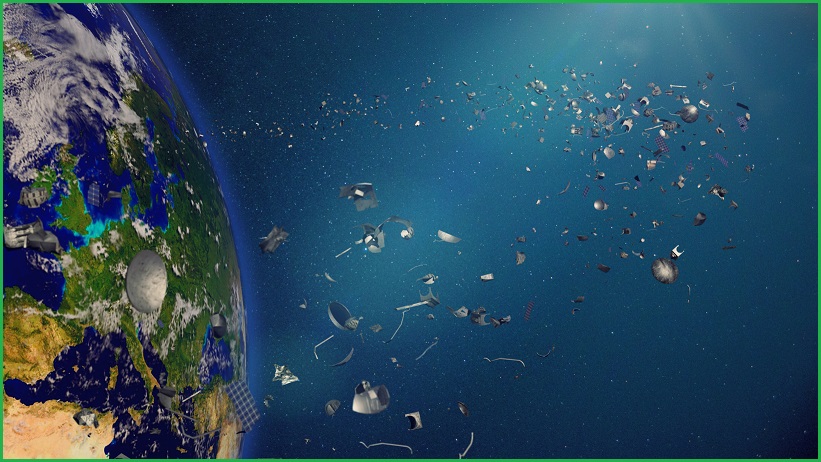Satellites have brought the world together like never before, but increasing congestion in Earth’s orbit is threatening the safety of space operations – pushing authorities to explore options including orbital janitors that would collect, destroy, or relocate millions of pieces of dangerous space junk.
The US Space Force, for one, recently called for private partners to help develop “debris mitigation and removal for non-cooperative objects” that would be collected for return to earth, ‘deorbited’ so they burn up in the atmosphere, or potentially vaporised using high-powered lasers.
With half of the 7,900 orbiting satellites already inactive and hundreds more launched yearly, “this debris and associated congestion threaten the long-term sustainability of the space domain,” vice chief of space operations General David Thompson said in announcing the Orbital Prime project, which he hopes will create a celestial garbage-collection service for hire.
It may be the stuff of sci-fi or a James Bond movie, but such efforts such efforts have become critical as accelerating commercial activity clutters space with small objects and dangerous fragments of space debris caused by events such as Russia’s recent destruction of a disused satellite with a missile – which created a cloud of potentially lethal debris that forced ISS astronauts to take refuge.
The US Space Surveillance Network (SSN) reports more than 23,000 artificial objects larger than a cricket ball orbiting the earth – peppered by half a million pieces of debris the size of a marble or larger, and an estimated 100m piece of debris larger than 1mm.
“The cost of access to space has dropped to the point now where regular people can go to space, or do things in space – and it’s getting very crowded,” notes Dr Chris Boshuizen, an Australian astronaut and entrepreneur whose co-founding of Planet Labs has put over 500 nanosatellites into orbit.
Projects like NASA’s Phonesat –which orbits customised smartphones for just tens of thousands of dollars each – have helped democratise space but created new risks, Boshuizen told the recent ISU Adelaide Conference on Space Junk.
“For $100,000, you can have your own space program,” he said. “And while it’s very exciting that we’re inviting new people, many of these people have different backgrounds – they’re educators, or artists, or finance people – and they may not have had that training that we had at NASA about just what is space debris.”
Tracking a growing problem
At orbital speeds of more than 28,000 km/h, even the smallest debris can damage critical communications, weather, defence or other satellites – as happened in 2009, when an obsolete Russian spacecraft hit an American Iridium satellite, creating more than 2,300 new pieces of space junk.
With more and more objects in orbit – 1,300 new satellites were launched in 2020 and well over 1,400 last year – experts increasingly worry about ‘Kessler syndrome’, where a single collision sparks an expanding cascade of space junk that damages critical satellites.
As commercial ventures enable humankind to litter orbit with the same impunity that we’ve afforded our oceans, authorities want commercial operators to step up and manage their debris before it causes a catastrophe.
“The numbers are getting kind of crazy,” Boshuizen said, “and if you’re going to launch small things like this, the onus is on operators to figure out how they can be tracked, and how to deal with the fact that they’re really small – almost below the size that can be detected from a camera on the ground.”
Watching space junk is no longer enough
National space agencies are pursuing a range of strategies to deal with space junk – and the Australian Space Agency (ASA) is far from the most proactive.
The New Zealand Space Agency, for one, not only requires space ventures to provide orbital debris mitigation plans but recently partnered with space-junk collection venture Astroscale.
ASA, however, is more focused on commercial space opportunities as it finalises seven core priority areas – one of which is SSA – and the agency so far has no plans to do more than look at space debris.
“In our analysis, [disposal] is something that we’re not ready to tackle just yet,” said Elizabeth Pearce, assistant manager for SSA and PNT with the ASA during a panel of space agency directors in which she noted only that the ASA “is dedicated to achieving responsible use of space.”
“We’re focusing on our competitive advantages,” she said, “participating in international collaborations and international conversations on the long-term sustainability guidelines as an agency.”
India, by contrast, is “very, very serious about space debris mitigation and we are putting all our efforts into improving our compliance level,” noted Bulbul Mukherjee, associate director of space situational awareness (SSA) and management with Indian Space Agency ISRO.
In line with India’s expanding space ambitions, ISRO opened a Space Situational Awareness Control Centre in Bengaluru a year ago and will track space debris through its Project NETRA early-warning system, combining long-range telescopes and a Multi-Object Tracking Radar that can pick out 10cm objects at up to 2,000km altitude.
“Accurate knowledge of space debris is really essential,” Mukherjee said, “otherwise we cannot make any informed decisions for spaceflight safety.”
“It’s high time we evolved a better approach than something which has purely been built on goodwill, or ad hoc interactions.”










